Is your content reaching your target market through all the clutter and the noise on the web? If not, you aren’t using it correctly and connecting content to maximize business growth.
Effective content marketing strategies are innovative, up-to-date, and engaging for your target market. They should be available to potential customers no matter how or where they want to make a purchase.
If you have been doing content marketing for a while, it might be time to revisit your strategy and improve it.
Competition is fierce, with almost 70% of businesses actively investing in content marketing. What can you do to stay relevant and boost traffic and sales?
1. Perform a content audit
A content audit is the process by which companies track down and organize all the content they have produced.
Regularly monitoring and measuring the performance of your content will help you determine which content performs the best and which doesn’t.
Start by reviewing all existing content on your site.
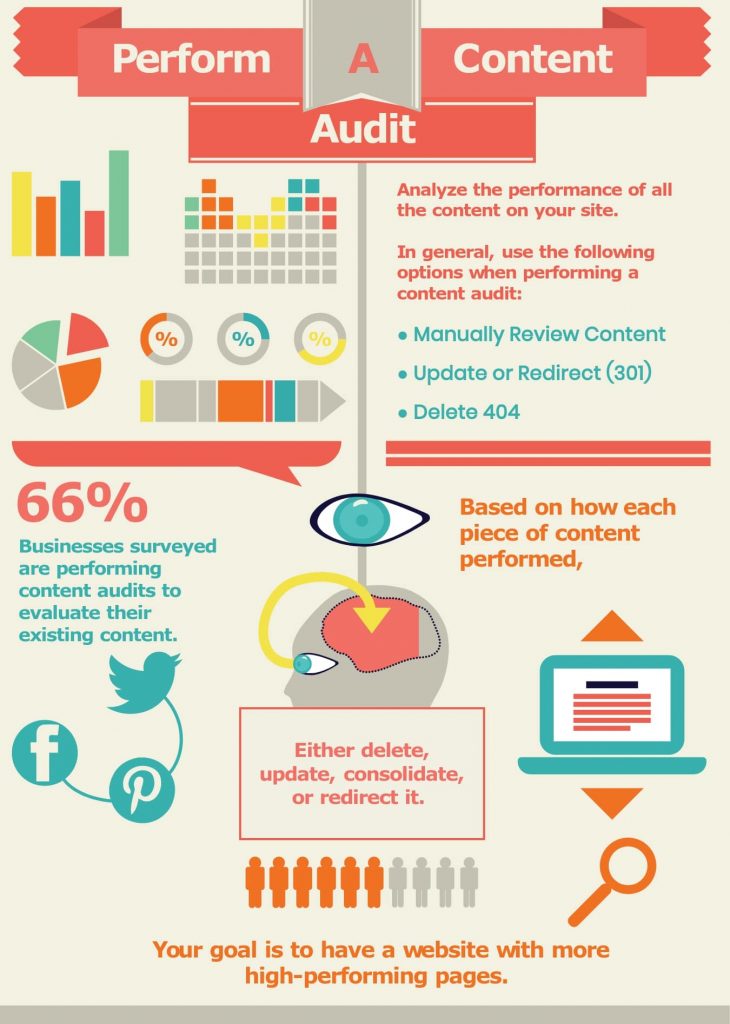
Based on how each piece of content performed, either delete, update, consolidate, or redirect it. Your goal is to have a website with more high-performing pages.
The best strategy is to improve and update older, irrelevant, or outdated content, rather than deleting and redirecting it elsewhere. This is especially true if the content of the post targets your business goals and a relevant keyword or phrase.
In general, use the following options when performing a content audit:
Manually Review Content: If your web page does get some traffic but very little from organic search, first, try improving it.
Update or Redirect (301): When you have at least one followed backlink but get minimal, if any, traffic from any source.
Delete 404: Use this option if your page has no followed backlinks and no traffic from anywhere.
Auditing your content enables you to determine which pieces of content are effective in reaching your goals and which are not. 66% of businesses surveyed are performing content audits to evaluate their existing content.
2. Create and use a content calendar
What and when you post content to your website and on social media is critical. Your strategy should be to produce a consistent flow of content that supports your overall marketing goals.
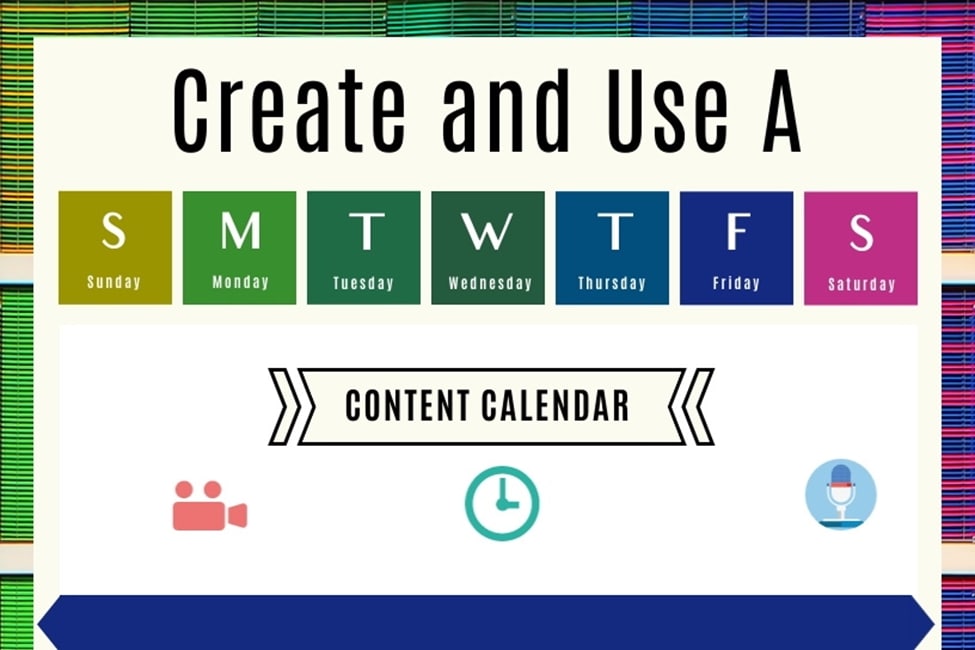
The visible display of topics becomes a shareable resource for everyone on your team to access and follow. Some of the issues and events to include on your calendar are:
- Local community events
- Timely topics
- National holidays
- Current events (should be updated when it is no longer relevant)
Scheduling your posts in advance allows you to spend more time focusing on other initiatives, such as recognizing relevant conversations and adding your voice in real-time.
Creating and following content calendars helps you stay on track, save time, and post relevant content regularly.
3. Write evergreen content
While current events are popular for a specific period, evergreen content is always relevant over time and less likely to become outdated quickly.
Evergreen content is not time-sensitive, so it remains valuable and always of interest to your readers.
Target your evergreen content to beginners on topics that are highly relevant to your niche. Use a variety of formats, including video, infographics, SlideShare presentations, images, and blog posts.
Below are several examples of evergreen content:
- Best practices
- Tutorials
- Case studies
- Common mistakes
- Tips and tricks
- Industry resources
- Guides
- Research
Some of the benefits of writing evergreen content include building backlinks, lowering bounce rate, and ranking higher in the search engines.
4. Incorporate search engine optimization (SEO)
The most successful content management strategies integrate with other digital marketing initiatives. When developing content, you need to incorporate SEO best practices to increase both the quantity and quality of organic traffic to your site from search engine results.
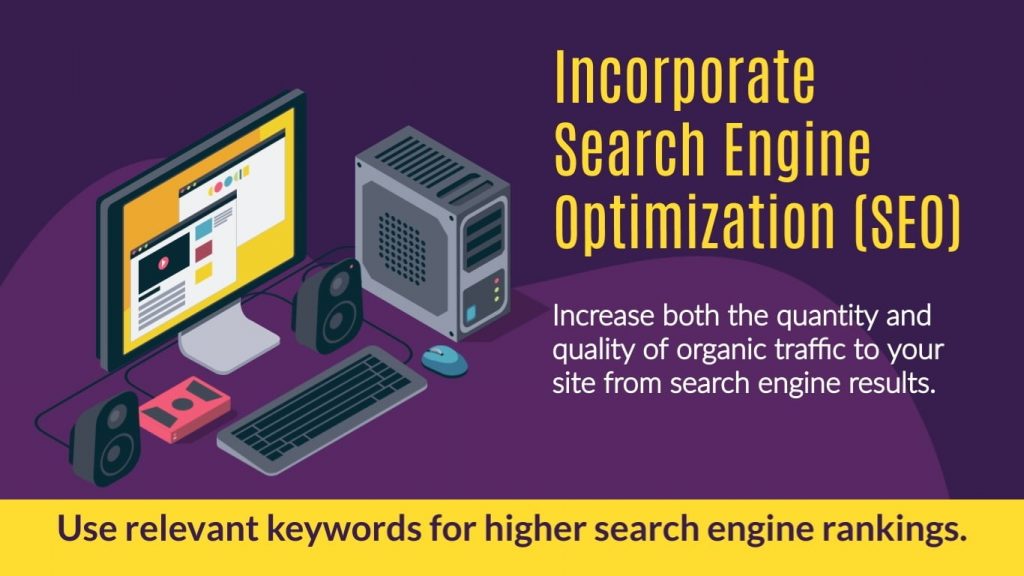
Your content must be optimized for both users and search engines. Although this is time-consuming, it is well worth the effort.
Keyword research is the most essential element of SEO. Find the keyword and phrases your target market uses in search engine queries.
Create your content around these words and phrases to increase your search engine rankings. When doing keyword research, look for long-tail keywords and phrases to bring in more relevant traffic.
Also, include semantically related keywords. These are phrases or words that relate conceptually to each other.
There are several free keyword tools to help identify the most relevant keywords and phrases for your content and niche, including:
- Google Search Console
- Keyword Tool Dominator
- Google Ads Keyword Planner
- Keywords Everywhere
- Rank Tracker
Keep in mind that there are several other on-page and off-page factors that also impact your SEO in addition to your content.
Some other factors include:
- Inbound links
- Backlinks
- Site architecture
Optimize your content for search to improve your online visibility. Most shoppers start by researching online for information about what they want to buy.
Help buyers find your brand when they are looking by using relevant keywords and phrases to show up higher in the search engines.
5. Repurpose popular content
Getting your content noticed in the crowded web can be challenging at best. Coming up with new and fresh ideas to write about consistently can be an overwhelming hurdle.
What if you did not have to come up with brand new content but could use existing content instead? Well, you can, and it is called repurposing.
Reusing all or parts of existing content in a different format will not only save you time, but it will also expand your reach and keep Google happy.
Because Google prioritizes dynamic content, even highly-ranked content should be updated to remain relevant.
Start by focusing on pieces of content that have received the most engagement. Below are some of the ways to breathe new life into your content:
- Put together case studies from collected internal data
- Create a SlideShare presentation from a blog post
- Build an infographic to represent post content visually
- Combine popular posts into an eBook, how-to guide, or whitepaper
- Tweet current statistics from content
- Convert existing content into videos
- Write blog posts from your content on Quora
- Remove the audio from narrated videos and turn into podcasts
- Compile most frequently asked questions from support into an FAQ page on your site
- Transform valuable content into an email series
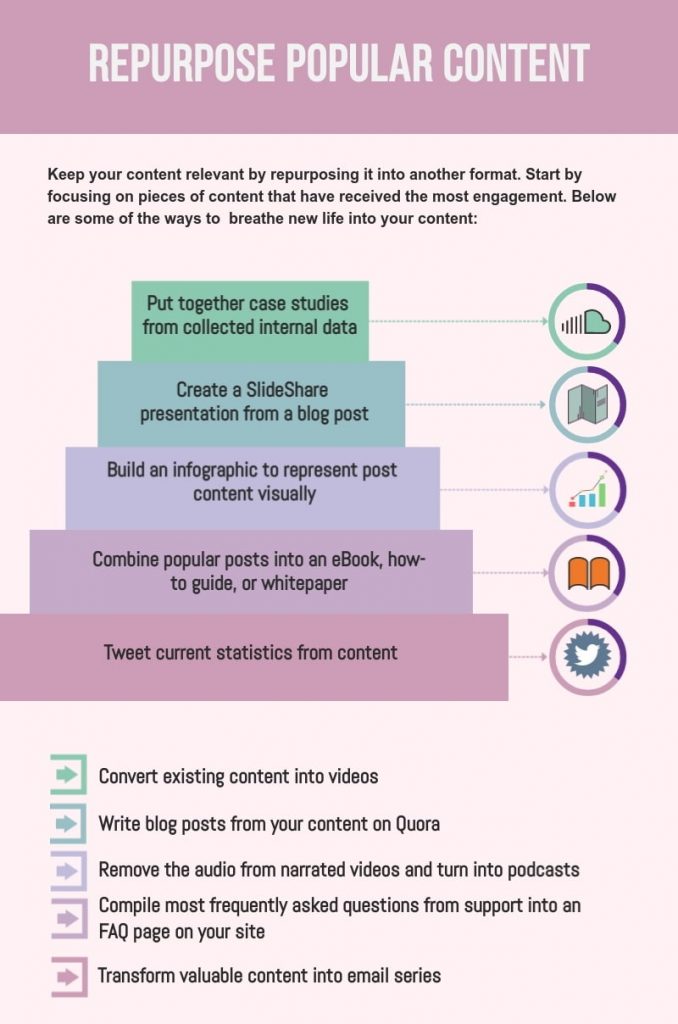
The best strategy for getting the most out of your content is to repurpose it for maximum effectiveness. The possibilities are endless.
Be sure to analyze and track your results, so you are only spending time on marketing initiatives that generate more traffic or increase sales.
6. Use compelling visuals
Engaging and compelling visuals are aesthetically pleasing and capture the attention of your target market.
Keep in mind that using stock photos will not drive as much engagement as custom images. So, what do you do if you are not a graphic designer or do not have one on staff?
Luckily, there are numerous online visual creation tools for non-designers to create unique, compelling, and attention-getting graphics. Some of the tools include:
- Canva
- Snappa
- Venngage
- Bannersnack
- Infogram
- Piktochart
- Visme
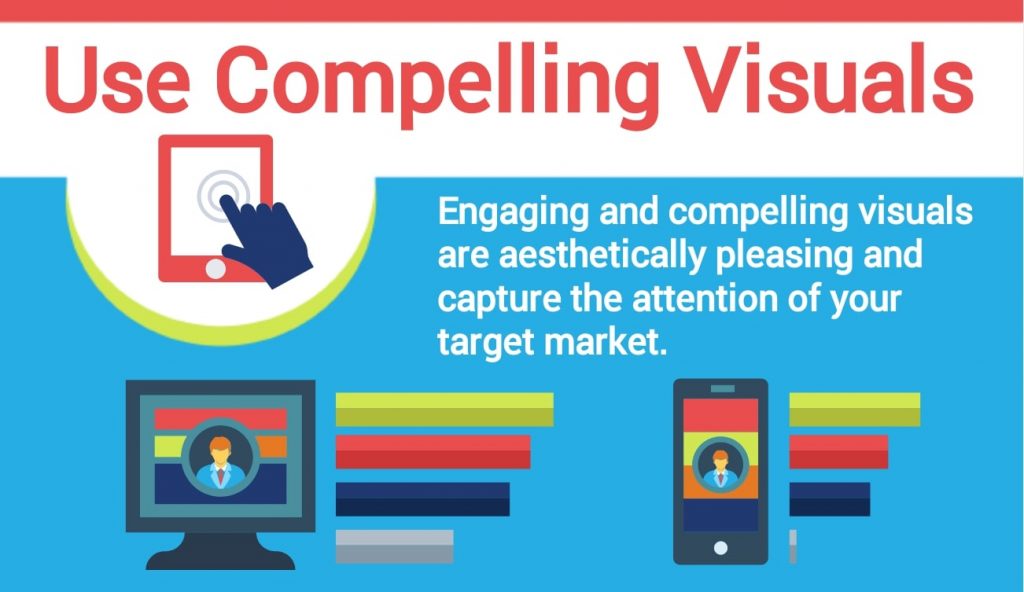
Breaking up large blocks of text with engaging visuals can keep readers on your site. You can use infographic elements, diagrams, or custom visuals.
Creative graphics enhance the memorability and shareability of your content. Make sure your visuals communicate your main point and are relevant to your content.
To increase recognition, incorporate your brand elements such as your company logo, colors, and font.
7. Segment your audience by analyzing customer data
Create all your content towards what your audience wants, needs, or likes. To understand your audience, analyze your customer data using a CRM or website analytics tool.
Start by looking at your customers’ demographics and group them by age, gender, income, geographical location, and other relevant factors.
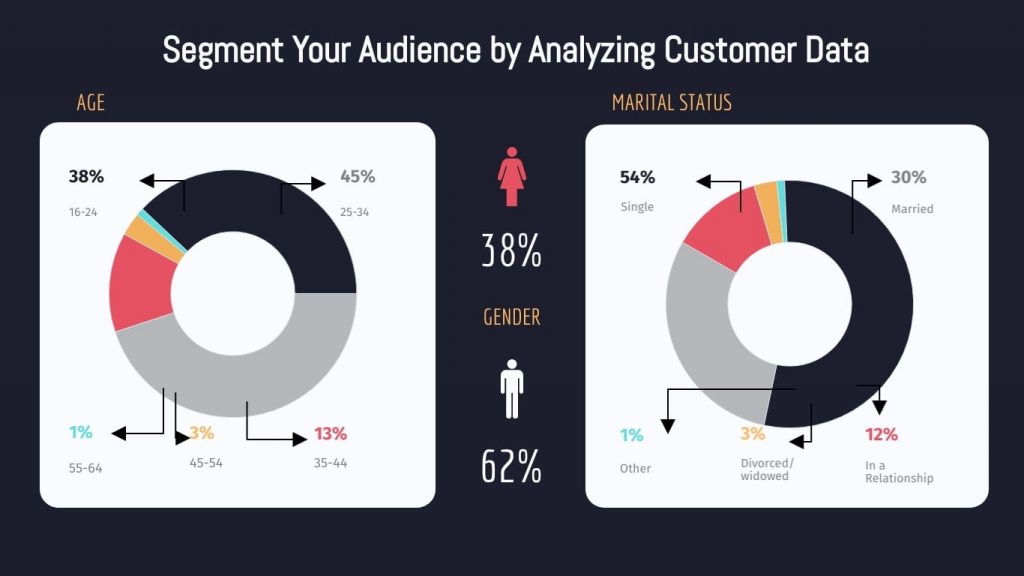
To know what types of content will drive traffic to your site, dig deeper into the data you have collected about the preferences and behaviors of current customers.
Most businesses will have different targets, also known as buyer personas. These segments vary by motivations, demographics, and interests but can also share one or more common traits, such as working parents.
To create personas, ask your customers in person, via interviews, or by sending out surveys. Another way to understand your target market is to monitor what your customers are saying and doing online.
Use a tool like Mention to monitor not only customers’ conversations, but also competitors, your industry, and other mentions of your brand.
Segmenting your audience provides a strategic method to generate content specifically tailored to different segments of your target audience.
8. Use emotion-based keywords in your headlines
Purchasing decisions are often based on feelings. Writing headlines that tap into people’s emotions will help them relate and want to read more.
When a headline instills a feeling in readers, they are more likely to pay attention to your content and share it with others.
Words have meaning, are powerful, and influence people. Companies work diligently to write words in their content that will engage viewers.
How can you go about writing emotional headlines? Start with an understanding of what is considered emotional.
Look at this list of highly emotional words according to copywriter Karl Stepp. The list includes some of the words below:
- Surging
- Genuine
- Unsurpassed
- Tested
- Exclusive
- Challenge
- Attractive
- Informative
- Instructive
- Unparalleled
- Fascinating
- Breakthrough
- Promising
- Innovative
- Authentic
- Proven
The headline is the first impression viewers have of your content. Take the time to come up with a relevant, emotionally based headline to make your content stand out on the search engine results page.
Once you have brainstormed a few ideas, you can use CoSchedule’s free headline analyzer to test your titles.
Your goal is to receive a green result of 70 or higher to get the most traction, use the right word balance, and best character and word length for search engines.

Coschedule will analyze your headline based on grammar, readability, and overall structure.
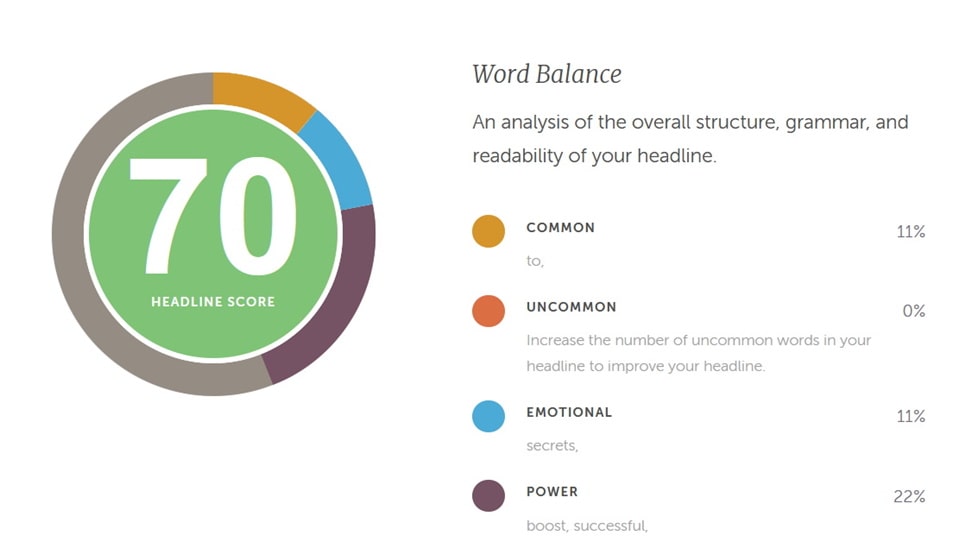
It will also offer more details to help you construct the most optimal headline, including emotional keywords.
Avoid using clickbait headlines. Instead, be sure your content delivers what your title promises.
9. Know the purpose of your content
Make sure you know what the purpose is for each piece of content you create. You want to be sure to cover all stages of the customer journey to support your prospects.
This will also help establish a relationship between your company and your customers. The different stages of the buyer journey are:
- Top of the funnel awareness stage that tells your brand story.
- Consideration stage to provide additional information to prospects who want to know more.
- Content designed to help potential customers know why you are their best choice while they are in the decision stage. Include client reviews and case studies.
- Create content to help current customers get the most out of your product or service. Offer additional helpful information for this retention stage.
- Highlight the most valuable aspects of your brand and spotlight corporate values to transform customers into brand advocates.
Measure your efforts
Before starting any new strategy, you must first define what you want to achieve, set goals, and define the metrics you will use to measure success.
To determine how well your content marketing efforts are performing, you need to look at the purpose of your strategy in relation to your business goals. Are you looking to:
- Get more brand exposure?
- Build customer loyalty?
- Achieve higher retention rates?
- Generate more leads?
- Build relationships with higher engagement rates?
- Increase revenue?

Develop a strategy to help you achieve your goals by setting up measurable and specific key performance indicators (KPIs).
Continue to track, monitor, and optimize your initiatives for improved results. For example, if your goal is to get more brand exposure, you can count or measure the number of comments, shares, and mentions your content receives.
Getting more eyeballs on your content is great, but what really matters is action.
Enjoy the fruits of your labor
Use the tips above to create better content and boost your online traffic. Keep a consistent and clear brand voice.
Produce content that is customer-focused because your target audience does not care about you or your plans. They care about their own challenges, problems, and desires.
While the Internet and evolving technology will continue to change, the core principle stays the same. Develop a strategy based on reliable data that provides a seamless and satisfactory customer journey.
Take the time necessary to build and implement a cohesive and integrated content management strategy, and your hard work will pay off with increased income.






